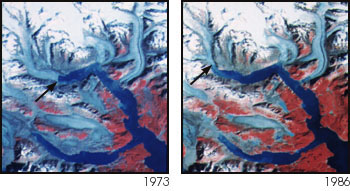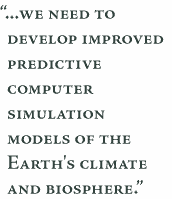|
Terra and Landsat-7 Land Surface Observations
The extent, type, and health of global
vegetation will be a key factor in determining the continental climates and the
rate of increase of atmospheric carbon dioxide in the near future. To understand
the important processes affected by vegetation and how these processes will
influence the future state of the Earth, we need to develop improved predictive
computer simulation models of the Earth's climate and biosphere. To make these
models work realistically we need to know more about the distribution and season
changes of the world's vegetation, as well as the exchanges of water and carbon
between land vegetation and the atmosphere. The only practical way to do this
consistently, continuously, and globally is through satellite remote sensing.
Satellite instruments have already been used to detect changes in photosynthetic
capacity, vegetation type, and growing season dynamics.

Figure 3: Satellite image of deforestation in the Amazon region, taken
from the Brazilian state of Para on July 15, 1986. The dark areas are
forest, the white is deforested areas, and the gray is re-growth. The
pattern of deforestation spreading along roads is obvious in the lower
half of the image. Scattered larger clearings can be seen near the center
of the image.
Terra and Landsat-7 will provide scientists with powerful tools for
monitoring the Earth's biosphere. Terra instruments such as the
Moderate-resolution Imaging Spectroradiometer (MODIS) and the Multi-angle
Imaging Spectroradiometer (MISR) will provide continuous global coverage,
permitting a thorough study of seasonal and inter-annual changes in land
vegetation. The high-resolution Advanced Spaceborne Thermal Emission and
Reflection Radiometer (ASTER, aboard Terra) and Enhanced Thematic Mapper
(ETM+, aboard Landsat-7) instruments will provide detailed information
about selected areas of special interest around the world; for example,
areas undergoing intense deforestation (Figure 3). Using the data from
these instruments, scientists will use computer models to study the
effects of a changing climate on global vegetation and the Earth's
biosphere.

Figure 4: These Landsat images, acquired 13 years apart, show
the retreat of the Muir Glacier (arrow) in southeastern Alaska. Between Sep 12,
1973 and Sep 6, 1986, the Muir Glacier retreated to the northwest more than 7 km.
The MODIS and MISR instruments on the Terra satellite will provide global
monitoring of snow and ice extent, while the ASTER and ETM+ instruments
will yield high-resolution images of snow and ice boundaries and glacier
retreat sites (Figure 4). ASTER and ETM+ will also enable us to monitor
inland waters, lakes, rivers and floodplains. (Hydrologists and
meteorologists currently do not have access to global flood data.)
Similarly, changes in the world's coastal zones and coral reefs will be
monitored with these high-resolution instruments.
back: Plants, Snow, & Ice
return to: Introduction
|
|

- Changing Global Land Surface
- Introduction
- The Carbon Cycle
- Greenhouse Warming
- Plants, Snow & Ice
- Terra & Landsat Observations
|


